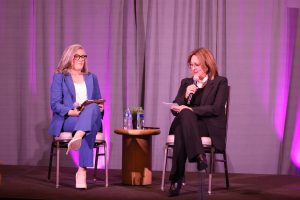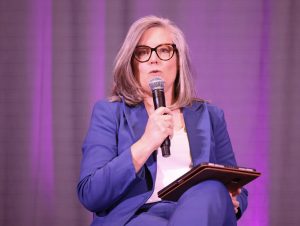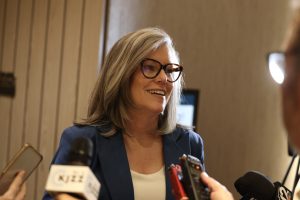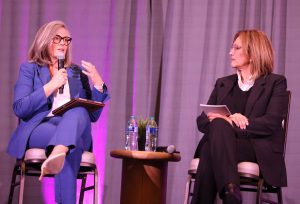- Slug: BC-CNS-Space Sector. 630 words.
- Photos available (thumbnails, captions below).
By Vanessa Pimentel
Cronkite News
PHOENIX – “Our opportunities are boundless, just like space,” Gov. Katie Hobbs told an audience at the second annual Arizona Space Summit in Tempe last month.
Arizona is the fifth-largest employer in aerospace and defense manufacturing, home to over 1,250 supply chain contributors, according to the Arizona Commerce Authority. Sandra Watson, the authority’s president and CEO, said Arizona has become the “global hot spot for emerging technologies and advanced manufacturing.”
Major industry players in Arizona have a significant impact on the economy. Together, these companies employ more than 52,000 people directly, according to the authority. Its website states the numbers reflect “Arizona’s long-standing history with leading names in the industry – companies whose continued success in everything from unmanned aircraft systems to missiles, space vehicles to commercial aircraft and research into alternative fuels – drives further future growth.”
“Arizona is open for business, and in our state you will find a partner with a shared focus on the future and one that is rooted in innovation,” Hobbs said.
Jessica Rousset directs Arizona State University’s Interplanetary Initiative, leading its strategy, collaborations and operations. She explains how the space sector reflects job opportunities, infrastructure and benefits for Arizona.
“We get a lot of data from space in terms of informing agriculture, informing mining. Mining is a huge activity here (in Arizona),” Rousset said in an interview. “So that’s a very interesting synergy between mining in space, mining on Earth.”
Rousset also mentioned the importance of space data in connection to industrial success in Arizona. Information from space can help manage things on Earth, such as water supply, which is essential to Arizona’s agriculture and semiconductor industries.
Rousset and Chase Kassel, portfolio manager of ASU’s Interplanetary Initiative, referenced a 2019 Deloitte study that said Arizona was the only state with the capability to provide the five critical segments of the space economy – aerospace, launch services, manufacturing, metals and mining, and research and development.
Hobbs said aerospace companies are looking to grow in Arizona and expand their operations due to the growing workforce, infrastructure, reliable energy and a diverse supply chain. Rousset said there is a “huge sort of economic activity” around these businesses that might not be as visible, but is responsible for creating jobs and hiring many people.
“Space needs all talents, all backgrounds, all cultures, all perspectives. The more inclusive we are in creating this space future for all of us, the more we can unlock for most people. I think that it is really important for the next generations to see themselves as being part of this,” Rousett said.
Arizona has a number of programs and initiatives targeted at getting students interested in STEM – science, technology, engineering and math – at a young age. An example of this is the work of the SciTech Institute, a nonprofit organization dedicated to enhancing and promoting STEM education and awareness in Arizona and beyond. The institute holds annual festivals and chief science officer programs.
“These programs promote the importance of STEM, of the STEM education. They empower children to pursue careers in STEM-related fields,” Hobbs said. “The exposure to fields that kids might have not thought possible is really critical.”
Bringing upcoming generations into the development of the space sector will shape the future. The University of Arizona is ranked top six for NASA-funded activity, according to the National Science Foundation. ASU is a top university for space science, ranking No. 8 in the U.S. for higher education research expenditures financed by NASA, according to the 2022 National Science Foundation’s Higher Education Research and Development survey.
“Collaboration really is key, and I think that Arizona does this better than any other state,” Hobbs said. “As our space leadership continues to grow, the universities will continue to be central to our success in this area.”



